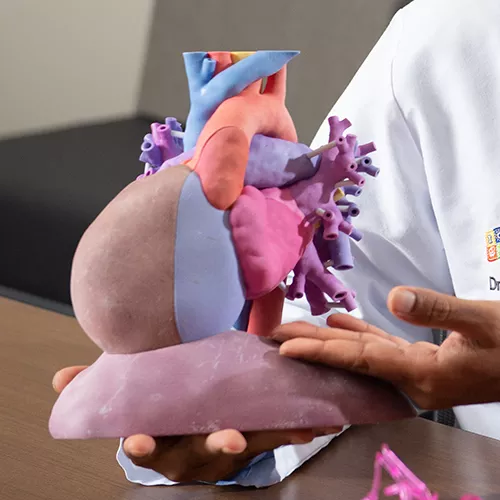Making it real: 3D printing and virtual reality technology improves surgical procedures and outcomes

At University of Iowa Stead Family Children’s Hospital, pediatric surgeons and interventional cardiologists use intricate, lifelike 3D models of human hearts to prepare for complex cardiac interventions on newborns and children. The use of 3D printing at the children’s hospital has had impressive results, with surgeons spending less time in the operating room and patients—including the tiniest and most fragile babies—having improved outcomes.
Now, the University of Iowa Hospitals & Clinics is moving to expand 3D printing across all Departments by partnering with Protostudios, a prototyping service within the university’s Department of Innovation and Economic Development. The goal is to establish a hub for medical device and advanced surgical tools development and the creation of patient organ replicas. Along with augmented reality, 3D printing can help other medical centers improve surgical procedures and recovery times. It can also be used in the classroom for learners and in clinical settings to help parents and families understand surgical procedures before they take place.
"In my work, we see this technology as having three important applications: for surgeons before they enter the surgical suite; for learners; and for families and patients so they feel reassured," says Ravi C. Ashwath, MD, clinical professor of pediatrics and director of non-invasive cardiology in the UI Stead Family Department of Pediatrics. "The 3D technology gives us the ability to provide excellent and accurate information, and that is something we want to share with other centers."
Visiting Ashwath's office provides a visitor with a glimpse at the future. Immediately inside his office door is a file cabinet upon which the doctor displays some of his most recent 3D creations. There's the heart of a newborn that barely fills one-third of Ashwath's palm, as well a 3D print of an adult's diseased aorta and a half-dozen other hearts, including several with artery branches sprouting from them.
The printer used to create these 3D hearts costs nearly a half-million dollars. It was provided to Protostudios through a grant from the Iowa Economic Development Authority to create a digital anatomy printing bureau as a statewide resource, according to Jon Darsee, the university’s chief innovation officer.
It’s an investment that Ashwath and others say will help recruit and retain doctors, attract medical students and trainees, and even provide revenue for the academic medical center. It will also improve surgical outcomes for patients. There are only a handful of hospitals across the nation using this kind of 3D printing to improve surgical procedures, and Ashwath is collaborating with them to stay on the cutting-edge technology.
"3D printing allows us to create facsimile organs with the same density and feel of the real organs,” says Darsee, “Achieving such realistic copies is an enormous breakthrough.”
The realistic dimensions and feel of the 3D hearts are what make them so useful and why more and more surgeons at Iowa are requesting them. In the three years since Ashwath started producing 3D models, interest in practicing on 3D models pre-surgery has increased to the point where some surgeons won't consider a complex operation without one.
"Once the surgeon practices with the 3D model, they feel confident going into the surgery—as if they have already done the surgery, as if it's all déjà vu," says Ashwath.
Made of a special resin and complex substances, the 3D models are so exact that they can be used in the process of fabricating valves and patches weeks before a cardiac procedure. Surgeons can practice on the models, including where they place stitches, and they can explore difficult-to-access portions of an organ in an office instead of inside a human chest.
"Imagine being able to measure a hole in a child's heart and create and test the perfect patch to repair that hole before surgery," says Ashwath. "It's a huge step forward."
Ashwath is proud of the work UI Stead Family Children’s Hospital is doing with 3D printing and augmented reality in surgical preparation, but patient stories are where he beams. Recently, a team of interventional cardiologists at the children’s hospital inserted a stented valve in the heart of a 10-year-old girl using a catheter, and they were able to perform this intricate procedure thanks to the practice they performed on a 3D model of the girl's heart.
"Instead of spending two to three weeks in the hospital, and getting her chest opened for the third time, the girl went home the next day after the procedure," says Ashwath. "She and her family were incredibly relieved."